We need your help to stop the spread of invasive species! Please report any new sightings of the following key invasive species. If possible, take a picture of the plant or pest and record its GPS location.
If the invasive you wish to report is not listed below, you can either log in or make an Invaders of Texas account, or email invasives@shsu.edu the location information and an image.
|

|
Giant Salvinia
Salvinia molesta
Giant salvinia is currently one of the most dangerous invasive aquatic plants in Texas. It damages aquatic ecosystems by outgrowing and replacing native plants that provide food and habitat for native animals and waterfowl.

|
|

|
Emerald Ash Borer
Agrilus planipennis
In infested areas, this beetle has killed hundreds of millions of ash trees and has led to major efforts by state and local officials to limit its spread through strict quarantines and fines for the movement of wood, especially firewood, out o...

|
|

|
Lionfish, Red Lionfish
Pterois volitans
Lionfish, which have no known predators (besides human), are the fastest growing coastal invasive, laying millions of eggs every month. They damage marine aquatic ecosystems by decimating life on reefs, including the small fish who keep the reefs he...

|
|
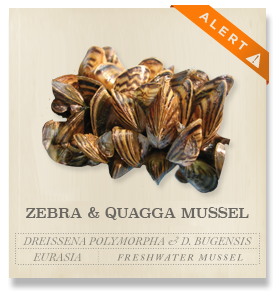
|
Zebra and Quagga Mussels
Dreissena polymorpha & D. bugensis
Zebra and quagga mussels are highly invasive, small freshwater mussels that multiply rapidly and can cause tremendous environmental and economic damage. Their larvae are microscopic, and the adults are usually less than 1 1/2 inches long. Zebra and q...

|
|
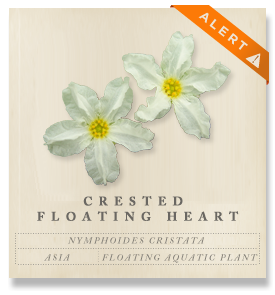
|
Crested Floating Heart
Nymphoides cristata
Crested floating heart grows rapidly, covering the entire surface of the water and shading out and outcompeting native vegetation. Decomposing vegetation impacts water quality and other aquatic species and shading can cause severe declines in algae, ...

|
|
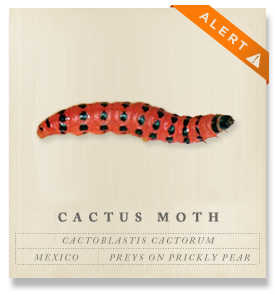
|
Cactus Moth
Cactoblastis cactorum
Cactus moth larvae live and feed
communally inside the pads of prickly
pear cacti. Damaged pads will show
characteristic oozing of internal plant
juices at the spines and insect droppings, will yellow as they become more damaged, and will become ...

|
|
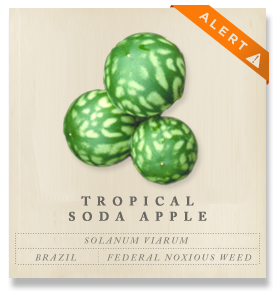
|
Tropical soda apple
Solanum viarum
Upright and thorny perennial shrub, 3 to 6 feet in height. Tropical soda apple is on the Federal Noxious Weed List. It reduces biological diversity in natural areas by displacing native plants and disrupting ecological integrity. This invader also se...

|
|

|
Yellow Floating Heart
Nymphoides peltata
Yellow floating heart grows rapidly, covering the entire surface of the water and shading out and outcompeting native vegetation. Decomposing vegetation impacts water quality and other aquatic species and shading can cause severe declines in algae, d...

|
|

|
Giant African Land Snail
Lissachatina fulica
A large terrestrial snail that can reach up to 8 inches in length and nearly 5 inches in diameter. The brownish shell covers at least half the length of the snail. Damages native plants and crops. Scientists consider the giant African snail to be one...

|
|
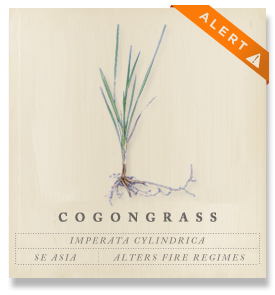
|
Cogongrass
Imperata cylindrica
Cogongrass has been ranked as one of the ten worst weeds of the world. It can invade and overtake disturbed ecosystems, forming a dense mat that makes it nearly impossible for other plants to coexist. Large infestations can alter the normal fire reg...

|
|

|
Redbay Ambrosia Beetle
Xyleborus glabratus
The redbay ambrosia beetle is a known vector of the vascular fungus Raffaelea lauricola, which causes the host plant to wilt and die within a matter of months or even weeks. In the southeastern United States, the reported hosts of the redbay ambrosia...

|
|
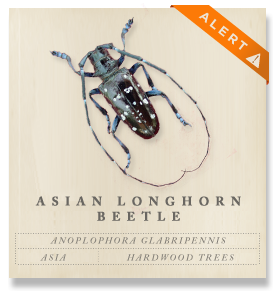
|
Asian Longhorned Beetle
Anoplophora glabripennis
This insect is a serious threat to many species of deciduous hardwood trees in the United States (e.g., maple, elm, willow, birch, horsechestnut, and poplar). During its larval stage, the ALB bores deep into a tree's heartwood, where it feeds on nutr...

|
|
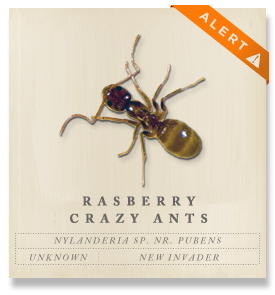
|
Tawny Crazy Ant
Nylanderia fulva
The tawny crazy ant (formerly Rasberry crazy ant), Nylanderia fulva (formerly Nylanderia sp. nr. pubens), was first found in Harris County in 2002 and has begun to spread largely through human assistance. If you see a lot of un...

|
|

|
Japanese climbing fern
Lygodium japonicum
Japanese climbing fern is an invasive climbing fern that is changing the landscape of East Texas. Introduced as an ornamental, it has escaped and is now rapidly spreading across the forested areas of Eastern Texas smothering native trees and shrubs....

|
|

|
Brown marmorated stink bug
Halyomorpha halys
The brown marmorated stink bug (BMSB), Halyomorpha halys, is an invasive insect that damages fruit, vegetable and ornamental crops in North America. Where BMSB becomes established, it causes severe crop and garden loses and becomes a nuisance ...

|
|
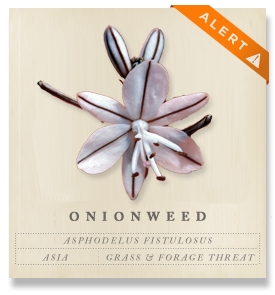
|
Onionweed
Asphodelus fistulosis
Similar in appearance to wild onion but lacking the onion scent and taste. Found in pastures and rangeland, onionweed develops populations that exclude grasses and desirable forage species. This federally regulated weed poses a serious environmental ...

|
|
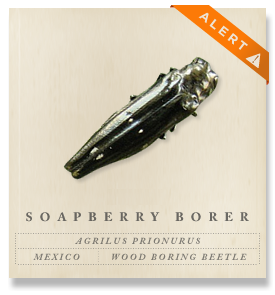
|
Soapberry Borer
Agrilus prionurus
Soapberry borers are rapidly killing soapberry trees throughout their range. Infested trees can be easily recognized by the exposed sapwood that results when birds and squirrels chip off the bark to feed on the larvae. Bark chips accumulate at the ba...

|
|

|
Tropical Spiderwort
Commelina benghalensis
Tropical spiderwort forms, dense, pure stands, smothering out other plants, especially low-growing crops. It has been reported recently as a problem in cotton in Alabama. In pastures, it grows rapidly over desirable grasses and legumes, competing wit...

|
|

|
Asian spongy Moth
Lymantria dispar
Formally known as the Gypsy moth. If established in the United States, each Asian spongy moth (ASM) female could lay egg masses that in turn could yield hundreds of voracious caterpillars with appetites for more than 500 species of trees and shrubs. ...

|
|

|
Brown Fir Longhorned Beetle
Callidiellum villosulum
Attacks trees in the Taxodiaceae. North American examples include the sequoia, redwood, and bald cypress. Due to the geographic isolation of some species, especially the sequoias, an infestation of these beetles could be especially dangerous. The Bro...

|
|
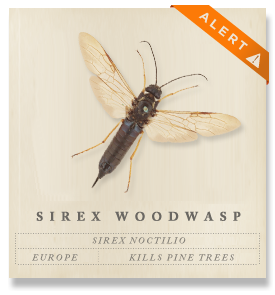
|
Sirex Woodwasp
Sirex noctilio
This woodwasp was introduced inadvertently into New Zealand, Australia, Uruguay, Argentina, Brazil, Chile, and South Africa. In these Southern Hemisphere countries, sirex woodwasp attacks exotic pine plantations, and it has caused up to 80 percent tr...

|
|

|
Giant Hogweed
Heracleum mantegazzianum
Giant Hogweed is an aggressive competitor. Because of its size and rapid growth, it out-competes native plant species, reducing the amount of suitable habitat available for wildlife. Giant Hogweed dies back during the winter months, leaving bare grou...

|
|

|
Apple Snail
Pomacea maculata
Apple snails (Pomacea maculata) can grow to up to six inches high -- about the size of a baseball or human fist -- although a size of approximately 1.5 inches is more common. Their presence is often first detected by observation of their brigh...

|
|
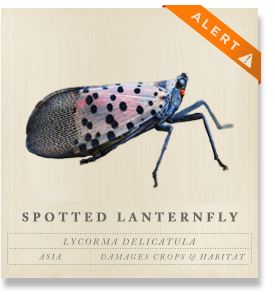
|
Spotted Lanternfly
Lycorma delicatula
The spotted lanternfly has long, tubular piercing-sucking mouthparts that are adapted to feeding from plant stems. It sucks on phloem sap. It feeds on over 70 known host plants, including economically important plants, particularly common grape vine ...

|
|

|
Asian Citrus Psyllid
Diaphorina citri
Asian Citrus Psyllids are small brownish insects (1/8 in.) that usually feed on the underside of leaves draining phloem from the plants. They feed with their heads down almost touching the surface of the leaf at about a 45° angle. It feeds on an...

|
|

|
Citrus Greening
Candidatus Liberibacter asiaticus
Huanglongbing (HLB) in Chinese literally translates to Yellow Dragon Disease and it is caused by phloem-limited bacterium. That means that this bacterium attacks the phloem system of plants which is like the circulatory system in animals. This bacter...

|
|

|
Jumping Worms
Amynthas spp.
Jumping worms have earned this common name because they will thrash around like angry snakes when moved. Unlike our European naturalized earthworms (Lumbricus spp.) that mill through the dirt and excrete nutrients back into the soil after dig...

|
Working out in the field can be a very rewarding way to combat invasive species. Whether you are collecting scientific data to be used by local, state, or national agencies and organizations or actually helping get rid of the invasive plants and animals, you will be able to see up close and personal the impacts of invasive species and the results of your efforts.Go to our Citizen Scientist Page.




































